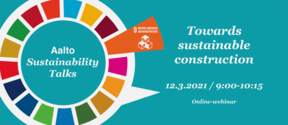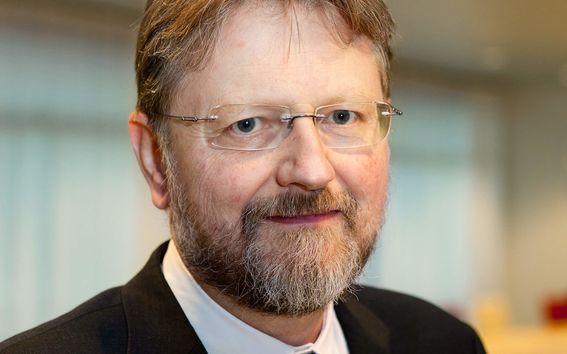Recording: Sustainable textiles - Still a dream or possible reality? (external link)
Recording of Aalto Sustainability Talks: Sustainable textiles - Still a dream or possible reality 16.4.2021


Recording of Aalto Sustainability Talks: Sustainable textiles - Still a dream or possible reality 16.4.2021
The textile industry faces numerous negative social impacts due to extremely precarious and unsafe working conditions, low pay, high labor pressure and more, to which the high environmental emissions associated with textile production also contribute. It is widely recognized that the present day textile industry is attached among others to unsustainable use of raw materials and water resources, excessive use of pesticides and fertilizers, generation of harmful wastes, and materials that contribute to the generation and accumulation of microplastics. As explicated in the UN Sustainable Development Goal (SDG 12, especially sub-targets 12.4 and 12.5) a shift to sustainable production means environmentally sound management and reduced release of chemicals and wastes to air, water and soil throughout their life cycle. At the same time waste generation must be minimized through prevention, reduction, recycling and reuse. Therefore, there is an urgent need for a sustainable textile value chain, new processes for environmentally friendly production of textile fibers and a paradigm shift in the textile industry away from the linear business model towards a circular resource model for clothing and textiles.
The presentations of this session sketch the future of sustainable textile production and an entire textile system from the viewpoint of new fiber production methods and transferring to circular economic ways?
Minna Halme, Professor of Sustainability Management, Aalto University School of Business.
Herbert Sixta, Professor of Chemical Pulping Technology at Aalto University School of Chemical engineering, Department of Bioproducts and Biosystems
Abstract: The first part of the presentation focuses particularly on three ambitions of the new textile economy, namely the elimination of substances of concern, especially microfiber emissions; the use of renewable resources; and third, the radical improvement of textile recycling through sustainable reprocessing. An overview will be given of the different technologies for the production of man-made cellulose fibers (MMCFs), which are currently being developed mainly in Scandinavia. The potential of these processes for the future requirements of sustainable textile fibers is highlighted. Selected examples will be used to demonstrate the significant advantage of chemical recycling of cellulosic waste textiles compared to mechanical recycling.
Michael Hummel, Associate professor at Aalto University School of Chemical engineering, Department of Bioproducts and Biosystems
Abstract: The second part of “Challenges and possible solutions for sustainable textile fiber production” will focus on the development and evolution of the Ioncell® process. The importance and growing demand of man-made cellulosic fibers is reflected by a steady increase in their production volume since several decades. This growth is mostly due to the expansion of viscose production capacities. The viscose process has been developed for over 100 years and has arrived at a highly optimized and versatile technology with a broad application portfolio. However, the overall sustainability of viscose fibers suffers from the implementation of toxic chemicals. Alternative spinning technologies are needed to satisfy the still growing demand of textile fibers. In 2009 Aalto University set out to develop a new Lyocell-type process based on green solvents, so-called ionic liquids developed together with the University of Helsinki. This process nowadays known as Ioncell® was intended to produce high-quality textile fibers from locally sourced wood-pulp. Once the right type of ionic liquids was identified it was found that the process is highly robust and allows to use also low-grade pulps and waste material to convert them into high-performance textile fibers. This includes waste cotton textiles which could become an important potential milestone towards a truly circular textile economy.
Pirjo Kääriäinen, Associate professor of Design and Materialities at School of Arts, Department of Design
Abstract: Environmental problems and changes in customer behavior and expectations are transforming the world of textile materials in coming years. Novel sources of raw materials and new production technologies are explored widely, and a transfer towards circular economy has started. The use of biological processes and synthetic biology might offer completely new solutions not only for material production, but also for dyeing and finishing of fabrics. At the same time the traditional methods and learning from the past have become a source of inspiration. What kind of pathways might be available to us on our way towards new textile materials and a more sustainable material world?

Minna Halme is Professor of Sustainability Management at Aalto University School of Business. Her research focuses on sustainability innovations, co-creation of sustainable business models and societal impacts of CSR. She has participated in several European research projects and heads a number of national ones.

Herbert Sixta is Professor of Chemical Pulping Technology at Department of Bioproducts and Biosystem. He has over 30 years of experience in industrial research on pulp, cellulose chemistry and biorefineries. Sixta’s core interest comprises the use of tailored ionic liquids for the selective dissolution of different biopolymers as a novel way of biomass fractionation. In material science the focus is laid on the development of high added-value cellulose material regenerated from ionic liquid solution as well as the synthesis of building block chemicals by heterogeneously catalyzed conversion routes from polysaccharides.

Michael Hummel is Associate professor at the Department of Bioproducts and Biosystems, Aalto University, with expertise areas on wood science, cellulose processing and biopolymer chemistry. In the group of Professor Sixta, Hummel and others developed a fiber spinning process, which is nowadays termed Ioncell®. His own research has since expanded to various biopolymers, striving for a better understanding of the properties and structure of biopolymers from various sources in order to eventually turn them into sustainable products.

Pirjo Kääriäinen is Associate professor of Design and Materialities at Department of Design. Since 2011, Kääriäinen has facilitated interdisciplinary CHEMARTS collaboration between School of Arts and the School of Chemical Engineering, together with a cross disciplinary team. CHEMARTS aims to inspire students and researchers to explore biomaterials together, and to create new concepts for the sustainable use of plant-based materials.

Aalto Sustainability Talks seminar series presents topical research making contributions to solving sustainability challenges.
Read Aalto's privacy notice here.